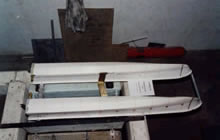
The London Jet installed with a standard Hysucat foil system operating on the Colorado River and Lake Havasu near Las Vegas.

Redlinger, a survey ship for the U.S. Army Corps of Engineers, at full speed trials in December 2009. The ship concept was developed on the basis of the Hysucraft principle of Foil Assisted Ship Technologies cc (FASTcc).

The 8m Hysucat RIB has been developed by Hoppe/Conradie by jumbodizing the 6,5m Hysucat of which nearly 500 units sold.
The hull has the same typical Hysucat hull with fully asymmetrical demi-hulls connected by the double arc-tunnel which has the ventilated tunnel step behind the bows.
View the video on youtube (http://www.youtube.com/watch?v=NxHPkhcDlRQ)
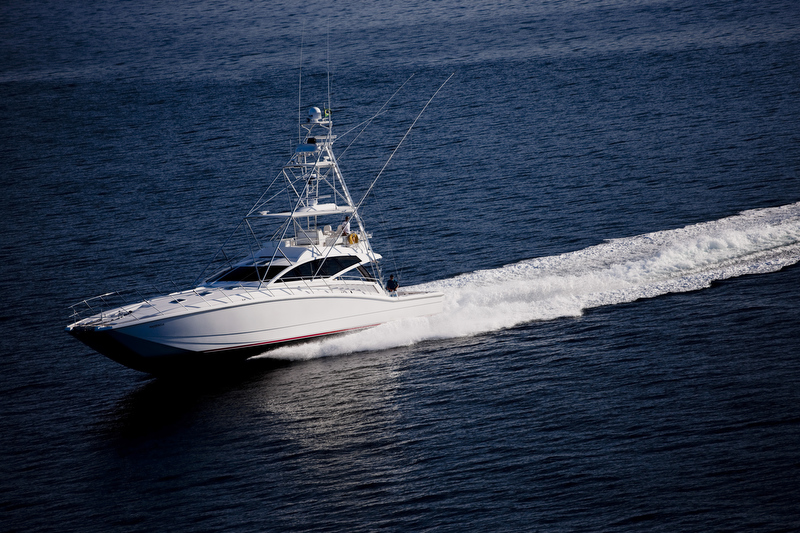
The photo shows the ProBoat 65 – Game Fishing Yacht off Angra Dos Rice in Brazil at high cruising speed of about 35 knots.
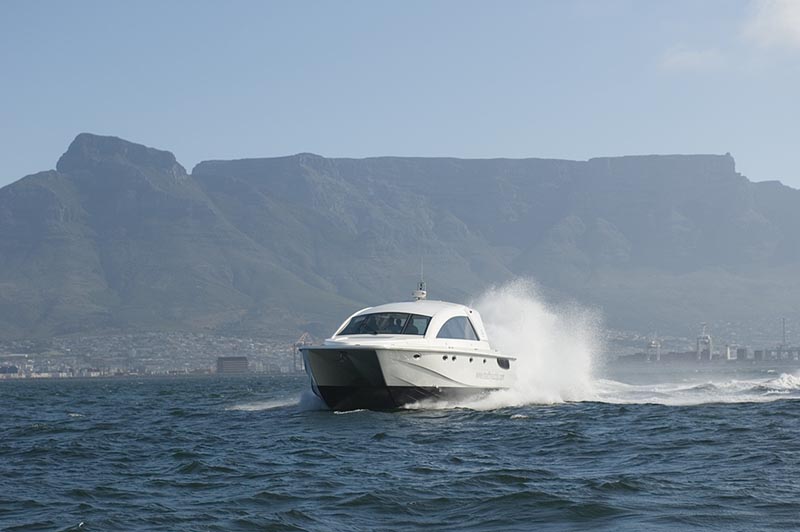
Initial trials were conducted on the Stealth Yacht 520 RUV, an Executive
Ferry of 16m and built by Stealth Yachts (Pty) Ltd. in Cape Town in Nov. 2008.
A second ferry was launched in July 2009.
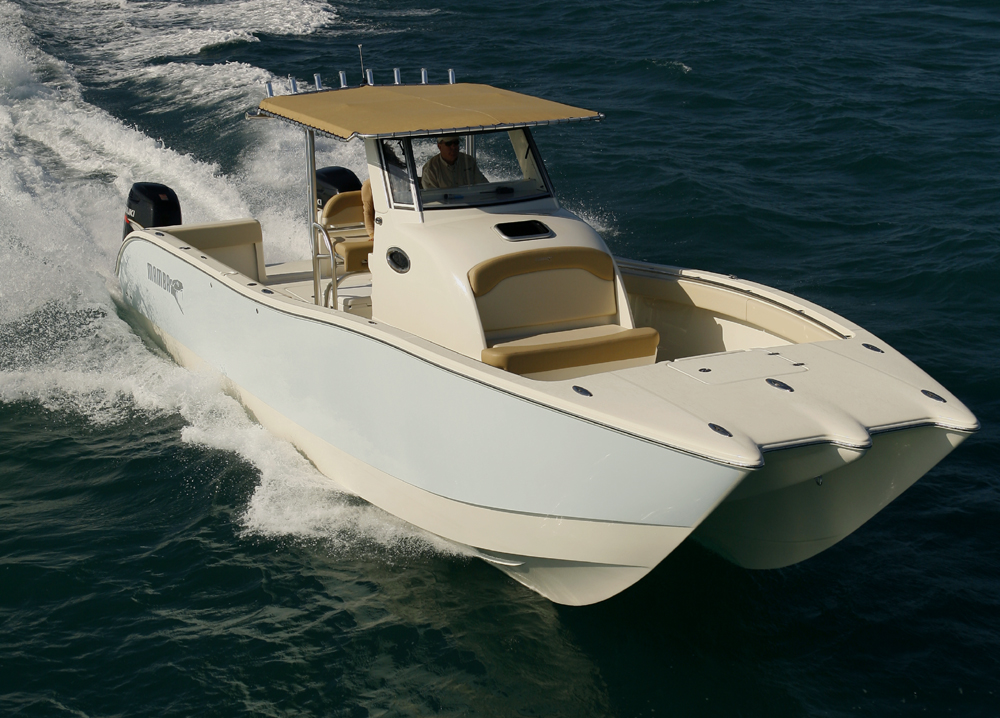
A 10.7m sea going Game-Fishing Hysucat was designed by FASTcc (RSA) in collaboration with Viking FCS (USA)
and built by Mamba Marine, Inc. in Florida/USA.
For more details click here ?(blue line text!)
A video can be seen at the Mamba Marine, Inc. website: www.mamba350.com
With courtesy from Mamba Marine Inc.
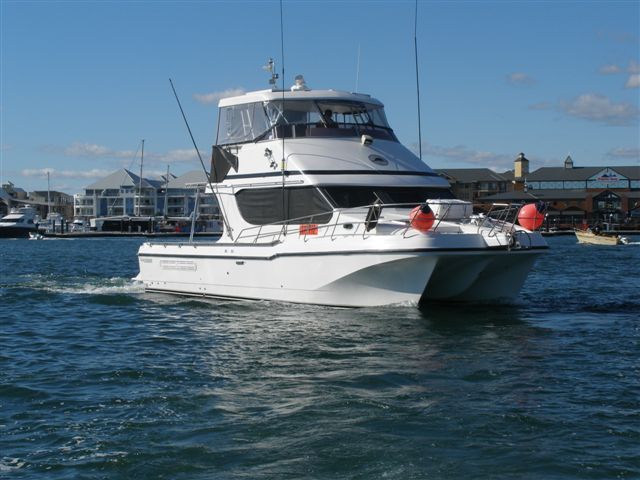
A Hysucat tandem foil system was designed in 2007 for a Cougar Catamaran which had been extended from about 12.5m to 14m length. Performance
and sea keeping were improved considerably. Click for more details.
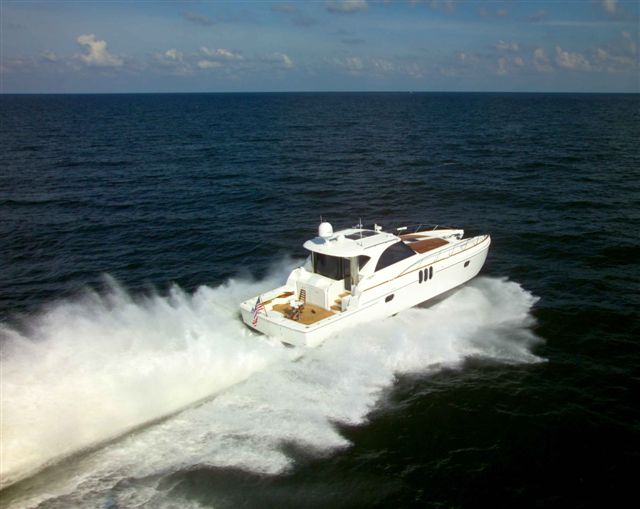
The photo shows the second Cat Cay 53′ Yacht built and which is operating around Dubai(UAE).This craft had hull and tunnel variations based on the experience with the original first CatCay Yacht in the USA.
FASTcc designed a Hysucat Tandem Foil System with adjustable rear foil for both Craft.
Full weight is higher for the UAE boat with special high luxury equipment (“fit for Royalty”!) and the full load weight is 24.040[t](53 000 lbs).
Propulsion is by twin 735 KW (1000 HP) Caterpillar C-18’s Diesels with ZF-Gearboxes (ratio 1.78) driving Sea Fury SF 30 drives which are equipped with 31″ x 39″ surface propellers.
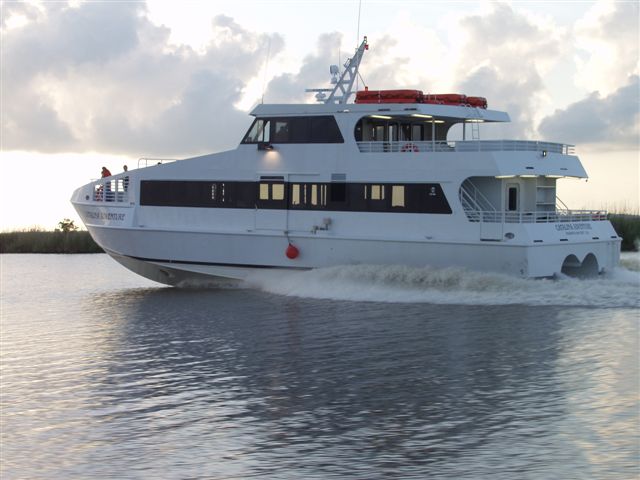
The Catalina Adventure was built by the Geoshipyard in New Iberia, Louisiana, USA as a high speed ferry for 149 passengers. The aluminum craft was designed in collaboration of FASTcc and Viking Fast Craft Solutions in Staunton, Illinois, USA on the typical Hysucat hull… (click for full story)
The Catalina Adventure was built by the Geoshipyard in New Iberia, Louisiana, USA as a high speed ferry for 149 passengers. The aluminum craft was designed in collaboration of FASTcc and Viking Fast Craft Solutions in Staunton, Illinois, USA on the typical Hysucat hull with a tandem foil system of which the rearfoil attack angle is hydraulically operated by the helmsman at speed.
The 24m ferry is propelled by twin Caterpillar C32 Diesel Engines with 2 * 1045 KW at 2100 rpm?s and displaces fully laden about 64t. Inclined shaft 5 bladed propellers in propeller-half tunnels are driven through ZF2550 gearboxes.
The top speed during trials was 34 knots and fully laden 31,5 knots, but operational speed is maximal 30 knots at 80% MCR. The hydrofoil system design and the hydrodynamic and propulsion data were conducted by aid of the Mathematical Hysucat program which was developed by FASTcc and which gave a good agreement with the achieved trial performance data which show that the fuel consumption of the foil assisted catamaran is considerably better than for usual craft.
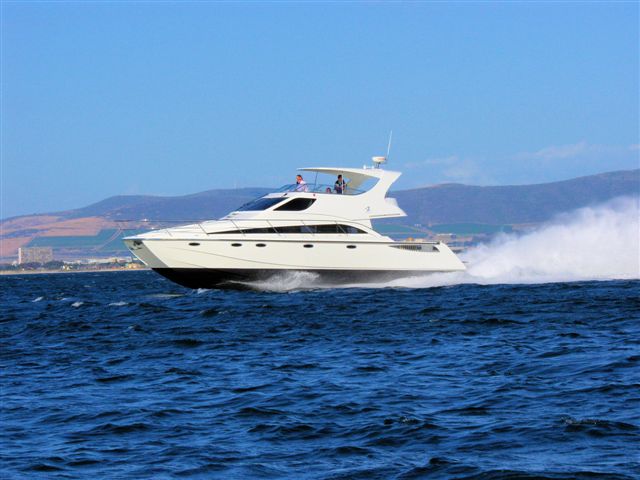
The Stealth Yacht 540 ? 1 was launched in December 2006. This Hysucat luxury yacht was built by Stealth Yachts (Pty) Ltd. in Cape Town.
The Stealth Yacht 540 ? 1 was launched in December 2006. This Hysucat luxury yacht was built by Stealth Yachts (Pty) Ltd. in Cape Town. The original hull design of a 50? prototype was done by Dr. Hoppe at FASTcc for Tallie Marine in St. Helena Bay. The ship design included hull shape, general cabin arrangement, weight estimation and distribution, hydrodynamic calculations and propulsion requirements all for the foil assisted fully asymmetrical catamaran. A plug and mould were built and later taken over by Stealth Yachts (Pty) Ltd who ?jumbodized? the hull, increasing width of demi-hulls and length for increased living space which also increased total weight and power requirements. The ship has a length overall now of 54? (16,46m) and beam overall of 5,45m. Full load displacement was estimated to be 20t, but finally ended up with 21t. Propulsion is by MAN twin high speed Diesel engines of 800 hp at 2350rpm each driving Q-Speed Surface Propeller systems. In the initial trials off Cape Town harbour a top speed of 46 knots was recorded inspite of very rough and choppy sea conditions. In flat water later 47,3 knots were reached with still reserves of about 8% in the top rpm?s. The contracted speed of 45 knots was well improved on. Further improvements are expected once the propellers are trimmed for optimal performance. See the photos of the Stealth 540 ? 1 in the initial trials. Further details will later be available through the webpage www.stealthyachts.com.
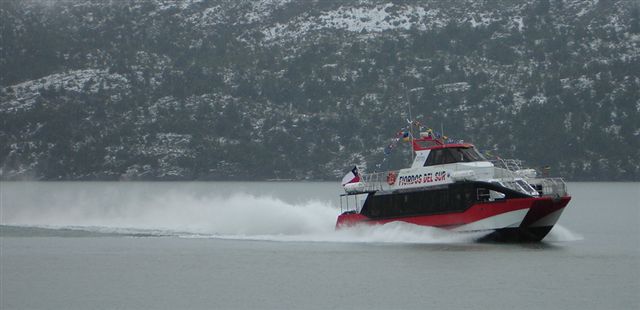
A fast ferry for 60 passenders was designed in collaboration with Alwoplast shipyard in Valdivia, Chile as a hydrofoil assisted catamaran with a tandem foil system in which the rearfoil attack angle can be adjusted by the helsman via a oil-hydraulic system.
A fast ferry for 60 passenders was designed in collaboration with Alwoplast shipyard in Valdivia, Chile as a hydrofoil assisted catamaran with a tandem foil system in which the rearfoil attack angle can be adjusted by the helsman via an oil-hydraulic system.
FASTcc developed the hull on the basis of the Hysucat with fully asymmetrical demi-hulls, bow inserts, wentilated wave-spoiler and deep-V-planing demi-hulls for rough water operation.
The lines plan and hydrostatics were produced by FASTcc and the detail design and the construction were conducted by Alwoplast.
FASTcc who conducted the hydrodynamic calculations for the hybrid, catamaran and foils, with the Mathematical Model of the Hysucat and predicted propulsion power requirements. The foil system was developed and designed for a topspeed of 37 knots at 22.5t and twin Cummins QSM11 Diesel engines with 432kW each turning out a bit heavier with some speed loss and it is operated between 30 and 35 knots on the Lago Grey in Chile. More details can be found on the website of Alwoplast www.alwoplast.com under the press release.
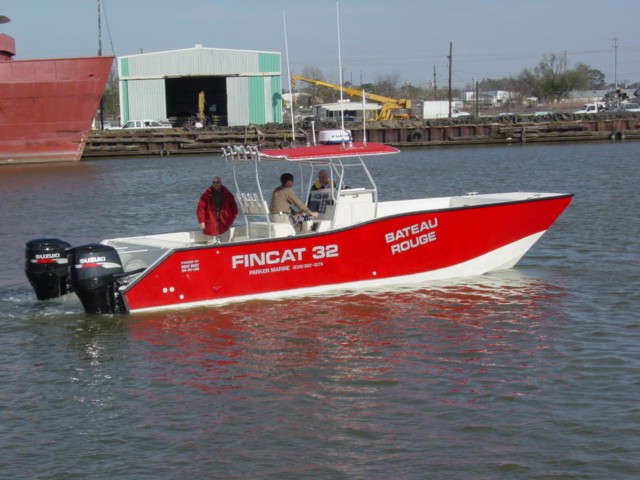
The 32′ Hysucat Game Fishing Boat by FASTcc/Viking FCS/Parker Marine.
The FINCAT 32? , a 9,5m Game Fishing Hysucat in Aluminium was developed in collaboration with Viking Fast Craft Solutions of Biloxi/USA and FASTcc as a light weight high speed fishing boat for extended trips far offshore.
The hull is based on the successful typical Hysucat hull with a foil-assist-system consisting of a mainfoil near midships and two trim-strut-foils near the transom.
The hull is of fully asymmetrical deep-V-planing demi-hull connected by double-arc tunnel, wave spoiler with ventilation step and tapered spray rail as used in optimised Hysucat designs.
Propulsion is by twin outboard engines of about 250 hp each and for most economical running with direct fuel injection. Optional 200 hp outboard can be used.
Several units with open-deck and with cabin were produced by Parker Marine, D?Iberville, MS, USA. For more details please contact the webpages:
Viking FCS: http://www.vikingfastcraft.com/
Parker Marine: http://www.fincatcatamarans.com/

A foil assisted system was designed by FASTcc for the Kvickak built 14.6m foil assisted catamaran pilot boat for the Virginia Pilot Association (Cheasapeake Bay). The catamaran hull was developed in collaboration with Kvickak Marine and shows up with the typical characteristics of the Hysucat adopted by FASTcc for rough water.
Photo Neil Rabinowitz and courtesy of Kvickak Marine
The Hysucat has fully asymmetrical demi-hulls with a wide and deep tunnel allowing nearly undisturbed flow over the two hydrofoils of which the second one near the transom is adjustable via an oil hydraulic cylinder.
This allows the helmsman to adjust the craft’s trim to best performance and softest sea keeping, usually a lower craft trim is selected running into headwaves and a larger trim in following seas to prevent bow steering.
The “Swift” has an overall hull length of 13.716 m (45′) and an overall beam of 5.791 m (19′), full load displacement is 22.1 t. With two Catapillars C18 Diesel engines of 715 HP at 2100 RPM and the twin disk gears 5114SC with a ratio of 1.12 to 1, driving Hamilton HJ403 water jets, the top speed is reported to be 37 / 38 knots. The foil system was build and delivered by Hydrofoil Manufacturers of SA at the end of 2004 and trial were conducted in the beginning of 2005.–%>
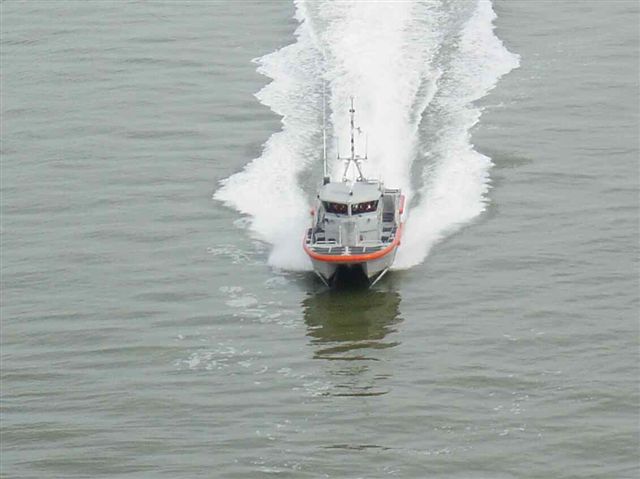
FASTcc in collaboration with Viking Fast Craft Solutions of Biloxi in the USA developed a Rescue and Fast Response Boat (RB-M) for the US-Coastguard based upon the optimised Hysucat hulls in combination with a hydrofoil-assist-system.
Photo: courtesy of the U.S.C.G.
FASTcc in collaboration with Viking Fast Craft Solutions of Biloxi in the USA developed a Rescue and Fast Response Boat (RB-M) for the US-Coastguard based upon the optimised Hysucat hulls in combination with a hydrofoil-assist-system.
The hulls are of the fully asymmetrical deep-V-planing hull with a double-arc tunnel, a ventilated wave-spoiler and a tapered spray rail as developed by Prof. Hoppe to achieve an optimum combination of hulls and foils for this hybrid with pleasant sea-keeping at high speeds.
Viking developed the arrangement and detail design in aluminium and construction drawings of hulls and superstructure for plate NC cutting.
As Rescue Boat the RB-M12 was to be equipped with a propulsion system for shallow water operation and high speed rough water capabilities and speeds over 40 knots.
Twin Yanmar Diesel engines with 2 * 310 kw, 2F280 gears and twin KaMeWa waterjets were selected.
The fully laden RBM displaces about 12 t and reached top speeds of 42,5 knots during extensive trial runs. Performance calculations were conducted with the Hysucat mathematical model and with the KaMeWa power-thrust-speed characteristics a speed of 42 knots was predicted which was well achieved during trials. The power ratio ep = ?Pb / (? * V) = 0,24 at a Froude Displacement number FnD = 4,02 indicates a very efficient high speed craft.
The builder Ocean Technical Services, Inc (OTECH) finalized the construction of this prototype inside 4 months after which the RBM12 was tested with two other competing craft of monohull design by the US Coastguard over 6 months in various sea conditions from calm to extremely rough.
The RBM showed up with surprising rough water capabilities. A final decision is still outstanding by the USCG. For more details contact http://www.vikingfastcraft.com or OTECH webpage: http://www.oceantech.com
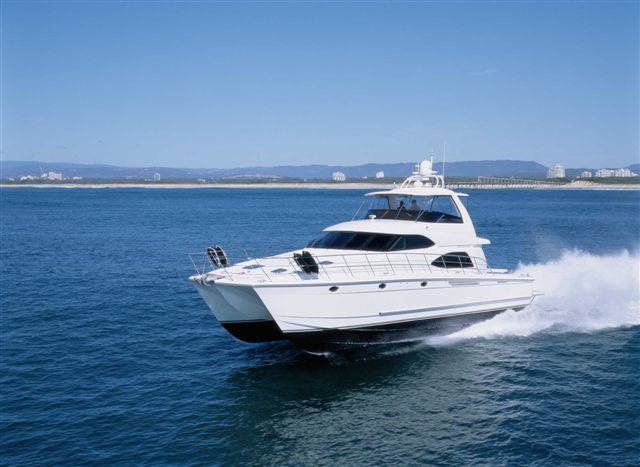
The 60′ ‘Cheetah’ Luxury Yacht of Innovation Marine. The catamaran with planing type fully symmetrical demi-hulls was designed by ?Matelli Designs? in Western Australia and the ship was built by Innovation Power Catamarans in Queensland / Australia.
The ship’s overall length is 17,5m excluding the swim platform and has a max. beam of about 6.00m. For more details contact the Innovation webpage at www.powercat.com.au
The Innovation displaces fully laden 41,5 t. The propulsion system consists of two MTU 12 183 TE 93 Diesel engines producing 846 kW (1150hp) @2400 rpm each and twin KaMeWa Waterjets FF550.
A Hysucat foil system was designed by FASTcc and built by the Cape Town foil builder and supplied by Hydrospeed. The installation was performed by the building shipyard in Australia.
The foil system consists of a large mainfoil spanning the tunnel width forward of the LCG position and two trim strut foils near the transoms. The foil systems is auto-trimming the craft at all speeds due to the foils operating in the so called hydrofoil surface effect mode. An efficient trim angle of the craft at speed is maintained without the need for foil angle adjustments (see attached photo series!)
Orginally twin KaMeWa A40 Waterjets were fitted and a top speed of about 40 knots was measured. However the fully loaded ship later became considerably heavier and at 40 t the ship had problems to get to the fully planing stage. To improve thrust in the mid speed range (15 to 20 knots!) the Innovation was upgraded with twin KaMeWa FF550 waterjets. The Diesel engines were left as before.
In recent trials the Innovation topped 38 knots at a full load of about 40t. The attached photo series shows these conditions at various speeds. The problem encountered earlier with surpassing the hump-resistance speed range was solved by use of the larger waterjets.
The top speed corresponds to a Froude-Displacement Number FnD = 3,38 and the power ratio ep = 0,221 which indicates a highly efficient high speed hull (see performance comparison in attached publications!)
More Details – Inovation Power Catamarans – www.powercat.com.au
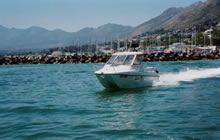
The 7.5m Skiboat with a front cabin, seating and fish box and swim platform was developed by Stealth Yacht in collaboration with FASTcc as a pleasure yacht and game fishing boat as a standard Hysucat hull. The craft can be equipped with Outboard engines from 2x85hp to 2x115hp and reaches speeds in excess of 40knots with a comfortable and sea friendly behavior.
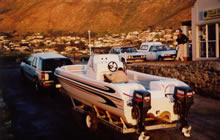
The 7.5m Skiboat of Stealth Yachts was developed out of elements of the successful 6.5m Hysucat RIB by Malan Conradie and Gunter Hoppe in collaboration with Hysucat Foil System of FASTcc. The craft is envisaged as a game fishing boat with walk-around console and comfortable seating for 8 persons. With two 85hp Yamaha outboard engines and 6 persons onboard it reached 42knots in the initial trials off Gordon’s Bay, RSA.

The 58′ “Moritz” is a further fast Survey Ship for the USACE, slightly longer than the “Irvinton” above and with a narrower tunnel but also equipped with a tandem foil system designed by FASTcc. The rear foil is adjustable by a simple bolt shift. The “Moritz” is stationed at New York. Full load displacement is 33.6t and it reached a top speed of 31.5knot with twin 700hp Detroit Diesel engines.
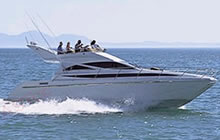
The 12m Stealth Yacht No. 2 on trials off Gordon’s Bay, South Africa. The ship is equipped with a Seafury Surface Propeller Drive propelled by twin Yanmar Diesel engines GLY2M-STZE producing 308 kW each. With an all up displacement of 10.8t the Stealth Yacht achived 44 knots topspeed on relatively calm waters. The luxury yacht was built on the recent ship design by FASTcc in collaboration with Malan Conradie of Stealth Yacht on styling and detail design for the USA Markets and features a FASTcc-Hysucat type hull by Prof. Hoppe with a S.P. Propulsion system with luxurious internal styling. The ship was launched on the 26 May 2003 and is now with Whitehall Marine in Ventura / California USA.
With an overall hull length of 11.95m and width of 4.10m the Stealth Cat 42′ displaces 10.8 t fully laden.
Propulsion is by twin Yanmar Diesels 6LY2M-STZE, 420 hp each and Teignbridge high speed propellers on inclided shafts.
Topspeed achieved is 38 knots and cruising speed 35 knots.
Type of craft : Open Sea Game Fish Version
he 12m Stealth Yacht No. 2 on trials off Gordon’s Bay, South Africa. The ship is equipped with a Seafury Surface Propeller Drive propelled by twin Yanmar Diesel engines GLY2M-STZE producing 308 kW each. With an all up displacement of 10.8t the Stealth Yacht achived 44 knots topspeed on relatively calm waters. The luxury yacht was built on the recent ship design by FASTcc in collaboration with Malan Conradie of Stealth Yacht on styling and detail design for the USA Markets and features a FASTcc-Hysucat type hull by Prof. Hoppe with a S.P. Propulsion system with luxurious internal styling. The ship was launched on the 26 May 2003 and is now with Whitehall Marine in Ventura / California USA.
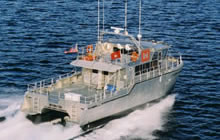
The Kvichak 54′ “Irvington” is a fast Survey Ship of the USACE stationed in Mobile. The Irvington has a Hysucat tandem foil system with an hydraulically adjustable rearfoil. She displases fully laden 31.34[t] and reaches a topspeed of 34 knots with her 2 x 700 hp Detroit Diesel engines driving inclined shafts with Teinbridge high speed propellers.
The power density is only 45[hp/t] and the power ratio ep = 0.19 at Froude Displacement numbers FnD = 3.18 which indicates a very efficient high speed craft. The USACE says that the survey recordings are of exceptional quality in single line scripts (without the usual wave up and down motions!) unseen on conventional craft and this is due to the hydrofoil damping effect also at low speeds.

The Yacht ?Molly? built by Alwoplast Shipyard in Valdivia in Chile was designed by Crowther Designs Australia and has typical semi-displacement type demi-hulls. A Hysucat and a Hysuwac foil system were designed for comparison. The Hysuwac has a 15% lower resistance in the middle speed range and about 5% at top speed. The Hysucat was selected to allow for beach landings and a tandem foil system with hydraulically adjustable rearfoil was designed with an increase in top speed from 22 knots to 32,5 knots. Molly displaces 22 t and propulsion is by twin Yanmar 8CX-ETE Diesels with 313 kW each. Read more in Publications attached.
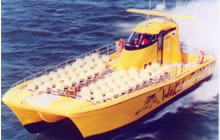
A foil system of the standard Hysucat type was designed and built for the Cougar Catamaran (Australia) the 14,6 m Wilcat, a touristic ferry with open deck seating for 54 passengers for offshore joy rides off Bermuda Island. Full load displacement is 22 t and propulsion is by twin Caterpillar 340 GE Diesel engines with 588 kW each and Seafury SF30 surface propeller drives which gave 49,8 knots in the initial trials. A top speed of 52 knots was calculated but the rpm?s were down by 365 rpm. The propellers were a bit over-pitched. Later the Wildcat made a Bermuda Challenger run (July 2000) with spectacular result until one engine failed and the boat had to with-draw 60 miles off Bermuda. So far no new race has been anticipated. The Wildcat operates from Bermuda Island offshore.
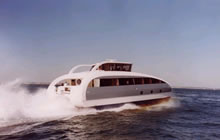
A so-called hydrodynamic stabilizer system was designed by Prof. Hoppe for the 21m Luxury Yacht Kingcat by the Kingcat Shipyard in France. This foil system is slightly different from the Hysucat principle but brings similar advantages. The hulls are of the symmetrical Deep-V planing type with extremely fin bows for soft running in waves. Two full beam foils with the rearfoil adjustable and the mainfoil not connected to the underwater parts of the hulls are installed. The Kingcat weighs 72 t and is propelled by four MAN D2842 Diesels of 880 kW each driving four Lips LJ 43KDL waterjets. It reached 44 knots top speed and 46 knots with 50% provisions. The hydrofoil system improved the ship?s hydrodynamic efficiency by 34% and lead to softer and very sea friendly behaviour in rough water.
View the video on youtube (http://www.youtube.com/watch?v=sbH1_wYFwmA)

Prof. Hoppe designed a 6,5m Rigid Inflatable boat on the Hysucat principle with hull, deck and propulsion and a standard Hysucat foil system in collaboration with Malan Conradie of Aquafun, later AquaCharters in Gordon?s Bay for styling and tool building and the production of the craft. The first tests with the prototype were run at Theewaterskloofdam, S.A in 1997. Today the company is trading as Stealth Yachts and has produced over 180 units mainly for export to the U.K, USA, Australia. With twin 50 hp the racing versions (special foil design!) reached top speeds of 50 knots in calm conditions. In rough water these craft show up with unbelievable smooth and soft ride comfort. Read more about the development in the attached publication under ?Publication? with the title ?Development of a Hydrofoil Supported Rigid Inflatable Boat?.
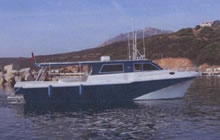
The 13m Cougar Catamarans built craft weighs in with 16 tonnes and got a Hysucat tandem foil system which was later extended to a hydraulically adjustable rearfoil. With twin 320 kW Diesel engines and Seafury SF26 surface propeller drives the craft reaches 38 knot with 16 t displacement and 40 knots with half load of about 14 t. The foil system increased the hydrodynamic efficiency by 32,8% and the speed by 15%. Read more about details in the Publications attached.
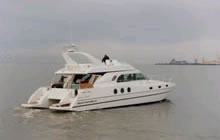
A Hysucat foil system was designed by Prof. Hope for the Prout Panther 64 Luxury Yacht of Prout Panther Ltd. in the U.K. which increased the top speed from 31 knots to 42 knots fully laden, 44 knots half load. The Panther?s are driven by twin MTU Diesel engines of 850 kW each and Vosper Thorny Craft waterjets (previously Parker Jets!). The first Panther 64 was trialed in England in 1998. Five further Panthers have been equipped with a foil system since.
View the video on youtube (http://www.youtube.com/watch?v=0OoQ_jm8VnU)
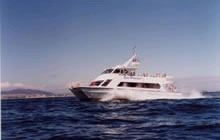
A Hysucat tandem foil system (rearfoil over full tunnel width) was designed by Prof. Hoppe for the catamaran ferry ?Sea Princess? of Mr. Girdlestone of Cape Town. The hulls were designed by Bob Van Niekerk on the basis of the former 20m T-Craft. Towing Tank model tests were conducted with various different foil systems but the tandem foil system gave the best result for this heavily loaded low powered craft. The craft displaces over 60 t with 120 passengers aboard and reached 32 knots with the 2 * 1000 kW MTU Diesels and the inclined shaft propeller systems by Teignbridge Propellers U.K. The ferry operates in sight-seeing tours around Cape Town.
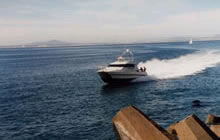
A 12m fast patrol offshore craft, called ?Horizon Interceptor? was developed on the basis of the 12m T-Craft hull by Bob Van Niekerk and a Hoppe-foil system. The craft is built by ?Stingray Inflatables? in Cape Town. The Interceptor is powered by twin Caterpillar Diesel engines with 320 kW driving Arneson surface propellers delivered by Teignbridge Propellers U.K. Three units were contracted for a foreign Navy and the 35 knot contract speed was easily succumbed with top speeds of 42/44 knots in the initial trials and endurance sea tests off Cape Town, S.A.
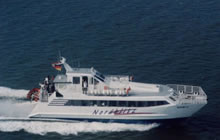
Type of craft: Touristic North Sea Ferry.
The original design of the Nordblitz has been for 40 knot top speed with 2 * 820 kW Diesel engines. The ship operates in the Baltic Sea in Sweden.
22m High Speed Ferry, Nordblitz, Bremerhafen, Germany with Servo Gear tunnelled CP-propellers, 115 passengers, alu-build, 58t full load displacement and 2 x 730 kW, Topspeed 32/34 knots.
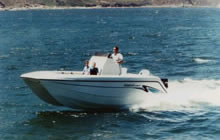
FASTcc designed the hull of a 6,7m Game Fishing Ski-boat for Hydrospeed with a standard Hysucat foil system. The craft displaces about 2,5 t fully laden and reaches top speeds well over 40 knots with twin 90 hp outboard engines.
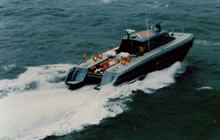
A hydrofoil system was designed for the T-Craft built 20m S.A. Navy Offshore Patrol Boats stationed in Simons Town, South Africa. The original demonstrator reached a top speed of 40 knots with a displacement of 28 t and 2 * 735 kW ADE Diesel engines driving Castoldi Waterjets. The later S.A. versions were heavier, around 35 t had Hamilton Waterjets, and reached 35 knots (others nearly 31 knots).
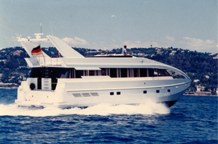
Luxury Yacht Ultimaratio built by Henze Werft in Bremerhafen, Germany 1990. The catamaran with fully asymetrical demi-hulls has a Hysucat canard foil system.
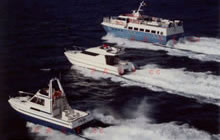
T-Craft Marine in Cape Town built 10m and 12m Hysucats in series. The hull design was by Bob Van Niekerk and the foil systems by Prof. Hoppe. A series of twelve 10m Police patrol boats were based on the 10m hull design, propelled by twin Diesel engines of 180 kW (later 220 kW). The craft reached 33 knots with 9 t displacement and Castoldi waterjets. The 12m Yacht in the middle of the photo displaces 13,5 t and reached 42 knots with Levi-Surface-Propeller drive systems.

Several aluminium built sport fisher boats with Hysucat foil systems designed by Prof. Hoppe were built in Australia by Cairns Custom Craft, sizes ranged between 5,6m to 10m.
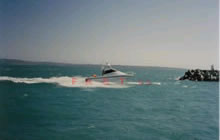
The Makaira Game Fishing boat of 8,5m and 4,5 t designed by Bob Van Niekerk was retro-fitted with a Hysucat hydrofoil system designed by Prof. Hoppe and showed up with considerably improved top speed and fuel economy, from 23 knots w/o foils to 38 knots with foils and twin 150 hp Outboard engines. One later version reached 42 knots with twin 200 hp Outboards. The craft were built by Makaira Marine in Cape Town.
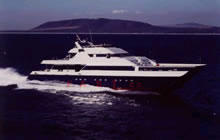
A Hysucat hydrofoil system was designed by Prof. Hoppe for the Luxury Yacht of Sir David Brown. The hulls were designed by Nigel Gee (U.K.). This 36m craft reached well over 38 knots with a fully laden weight of 140/150 t displacement and 2 KaMeWa waterjets driven by 2 * 1940 kW MWM Diesel engines. The craft operates in the Mediterranean Sea out of Monte Carlo.
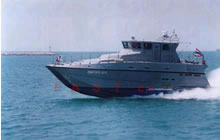
A Thailand 18m Luxury Yacht was developed in collaboration with Hysucat Engineering Germany for a Thai Boat Yard, Silkline Marine in Bangkok which built the craft. On the same hull two fast Custom Patrol Hysucats were finalized. The 18m craft were the fastest Hysucats for several years (except for the smaller 6,5m Hysucat RIB?s used in offshore races!) reaching 47 knots with Arneson surface propeller drive system and 2 *730 kW MTU Diesel engines and 28,5 t displacement. Hull lines and foil system by Prof. K.G. Hoppe

Launch Date : October 1986
The Hysucat H18 was developed by Prof. Hoppe (hull lines, propulsion and foil system!) in collaboration with the German associates Hysucat Engineering Germany as a fast Thai Patrol boat for offshore operation and protection of oil facilities. The builder was Technautic Shipyard in Bangkok, Thailand. The H18 weighs 36,5 t fully laden and is propelled by twin MWM Diesel engines developing 2 * 626 kW and an especially designed inclined shaft propeller system developed by Prof. Hoppe in collaboration with Schaffran L?beck (Propeller manufacturer), Germany for high speeds, see photos attached.
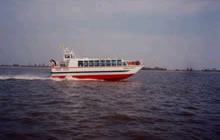
The “Rheinjet” for the Koln-Dusseldorf operator “kD”is a fast river ferry for touristic transport with extended site seeing tours on the river Rhein in Germany and Holland. The ship can carry 70 passenfers at 40 knots. The propulsion system consists of 2x500kW MAN Diesel engines driving Servo Gear controlable pitch propellers on inclined shafts. The propellers are arranges in propeller-half-tunnels for low draft requirements (see Photo!). Low wake formation at high speed was a design request. The ship was built by the Henze Shipyard in Bremerhafen, Germany in 1994 with the hull lines and general ship design including poering and the development of the propeller-hull-tunnels with conceptual engine arrangements conducted by Dr. Hoppe (now FASTcc). The hydrofoil-assisted-system consisting of two full beam hydrofoils in tandem arrangement (see Photo) was developed by Dr. Hoppe and included the detail foil design concerning hydrodynamic optomisation of shape and settings, cavitating free operation to 45knots and the detailed streangth analysis. The hull was built of carbon-fibre-GRP-mix with honeycomb of kevlar (re-jects by air industry!) in a special system not requiring mould and allowed the low total weight of 28t for the fully loaded ship. A top speed of 42 knots was reached after the propelle blade tips had been trimmed in Holland. The craft reached one of the lowest power ratios ep=0.169 at a Froude displacement number of FnD=3.96 and is one of the most efficient Hysucats build so far. The Rheinjet is operating now in Holland.
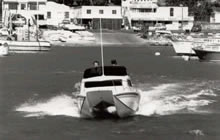
Launch Date : July 1982
The Buro for Mechanical Engineering at the University of Stellenbosch, RSA (BMI) started to market the Hysucat Principle after several model test series had shown that more than 40% resistance reductions are possible when a hydrofoil system is fitted to the catamaran. The 5,6m BMI-Hysucat was sponsored by the BMI to prove that practical and well functioning Hysucats can be produced with considerably improved sea keeping.
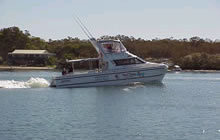
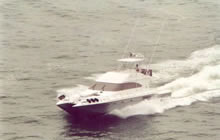
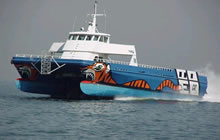
A special foil assist system was developed for the Halter Marine E-Cat ferry demonstrator which has semi-displacement demi-hulls and operates at relatively low Froude Numbers but sill allows improvements of 40% against the E-Cat without foils. Trials were run off New Orleans and confirmed the predicted improvements.
Later wash measurements confirmed that the wake of the E-Cat with foils was considerably lower than of any other high speed ferry.
With 175t to 182t the E-Cat reached 46 knots top speed even though the foil design was optimzed for 40 knots.
Propulsion is by twin Caterpillar 3576B 1,910 kW Diesel engines and Bird-Johnson 650 waterjets.
The transport efficiency in inversed form ep = 0,103 at a Froude Displacement Number of FnD = 2.92.
Find more details in Publication No. 4 of our website and see the main foil system operating at 30 to 46 knots with appearance of hyper ventilation (flow turns white on foil top surface!) on Youtube (http://www.youtube.com/watch?v=p_yPR7yWm-Q

